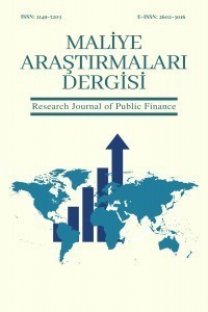Küresel Finansal Krizin BRIC Ülkeleri Üzerindeki Makro Ekonomik Etkileri
2007 yılında Amerikan konut ve varlık piyasalarındaki sorunlardan kaynaklanarak başlayan finansal kriz, kısa zamanda tüm dünyayı etkisi altına alarak global bir krize dönüşmüştür. Böylece küresel ekonomide büyüme hızları yavaşlamış, işsizlik oranlarında artışlar gözlenmiş, ihracat miktarları düşmüş ve sermaye hareketleri azalmıştır. Küresel finansal krizin yıkıcı etkilerinden en fazla etkilenenler başta AB ülkeleri olmak üzere gelişmiş ülkeler olmuştur. Ancak küresel finansal kriz, yükselen piyasa ekonomileri üzerinde de bir takım negatif etkiler bırakmıştır. Bu makalenin amacı küresel finansal krizin BRIC Brezilya, Rusya, Hindistan ve Çin ülkeleri üzerinde meydana getirdiği makro ekonomik etkileri ortaya koymaktır. Çalışmadan elde edilen bulgulara göre BRIC ülkeleri küresel finansal krizden ekonomik bir çöküntü yaşamadan sadece ihracat, büyüme ve yabancı sermaye yatırımları gibi makro ekonomik göstergeler açısından kısa süreli bir daralma yaşayarak çıkmıştır. Bunun en temel gerekçesi de 1990’lı yıllarda serbest piyasa ekonomisini tüm unsurları ile kabul eden BRIC ülkelerinin küreselleşmenin avantajlarını oldukça olumlu bir şekilde değerlendirmeleridir.
Anahtar Kelimeler:
Küresel Finansal Kriz, BRIC Ülkeleri, FED’in Para Politikası
The Macroeconomic Effects of Global Financial Crisis on the BRIC Countries
In 2007, the American housing and equity markets started by financial crisis, caused by a problem in a short time has developed into a global crisis taking hold of the whole world. Thus, the growth rate slowed in the global economy, observed increases in unemployment rate, export quantities and capital movements. The devastating effects of the global financial crisis whose interests may be affected by the most developed countries, including the countries of the EU in the first place. A hits the global financial crisis, emerging market economies has a number of negative effects on. The aim of this article is to examine macro-economic effects of the global financial crisis that bring on BRIC Brazil, Russia, India and China countries. According to the findings from article, the BRIC countries have lived without an economic collapse of the global financial crisis, export only, such as macro-economic growth and foreign capital investments in terms of short term indicators by a contraction. The main reason here too that in the 1990s, free-market economy with all elements of the advantages of the BRIC countries that accepts globalization in a way that is very positive reviews
___
- CASE, Karl E. (2008). “The Central Role of Home Prices in the Current Financial Crisis: How Will the Market Clear?”, Brookings Papers on Economic Activity, Vol.2008, Fall-2008, (pp.161-193).
- GADDY, Clifford G. and Barry W. Ickes (2010). “Russia after the Global Financial Crisis”, Eurasian Geography and Economics, Vol. 51, No. 3, 2010, (pp. 281–311).
- GREEN, Duncan; Richard King and May Miller-Dawkins (2010). “The Global Economic Crisis and Developing Countries: Impact and Response”, OXFAM International Research Report, http:///www.oxfam.org, January-2010, (pp.1-70).
- HUANG, Jikun; Huayong Zhi, Zhurong Huang, Scott Rozelle and John Giles (2011). “The Impact of Global Financial Crises on Off-Farm Employment and Earnings in Rural China”, World Development, Vol.39, No.5, 2011, (pp.797-807).
- IMF, Country Report for Brazil, No.12/192, 2012, (pp.1-71).
- IMF, Country Report for India, No.12/96, April-2012, (pp.1-42).
- IMF, China Economic Outlook, February 6, 2012, (pp.1-10).
- JAMES, E. William, Donghyun Park, Shikha Jha, Juthathip Jongwanich, Akiko Terada- Hagiwara and Lea Sumulong (2008). “The US Financial Crisis, Global Financial Turmoil and Developing Asia: Is the Era of High Growth at and End?”, Asian Development Bank (ADB) Economics Working Paper Series, No.139, December-2008, (pp.1-76).
- JANSEN, Marion and Erik Von Uexkull (2010). Trade and Employment in the Global Crisis, International Labour Office in Assocation with Academic Foundation, Geneva, 2010, (pp.1-174).
- MLACHILA, Montfort and Misa Takebe (2011). “FDI from BRICs to LICs: Emerging Growth Driver?”, IMF Working Paper Series, WP/11/178, July-2011, (pp.1-31).
- NANTO, Dick K. (2009). “The Global Financial Crisis: Analysis and Policy Implications”, CRS (Congressional Research Service) Report for Congress, October-2009, (pp.1-151).
- NAUDE, Wim (2009). “The Financial Crisis of 2008 and the Developing Countries”, United Nations University, UNU-WIDER, (United Nations University-World Institutions for Development Economics Research), Discussion Paper, No.2009/1, January-2009, (pp.1-20).
- OVERHOLT, William H. (2010). “China in the Global Financial Crisis: Rising Influence, Rising
- Challenges”, The Washington Quarterly, Vol.33, No.1, January-2010, (pp.21- 34).
- REAVIS, Cate (2009). “The Global Financial Crisis of 2008–2009: The Role of Greed, Fear and Oligarchs”, MIT Sloan Management, July-2009, (pp.1-22).
- REINHART, Carmen M. and Kenneth S. Rogoff (2009). “The Aftermath of Financial Crises”, American Economic Association Meetings in San Francisco, Session on International Aspects of Financial Market Imperfections, January-2009, (pp.1-12).
- SNOWDEN, Nicholas and Jesus Munoz, “Building a BRIC? Stock Market Opening and Investment Finance in India since Liberalization”, World Development, Vol.40, No.6, 2012, (pp.1109-1121).
- TAYLOR, John B. (2009). “The Financial Crisis and the Policy Responses: An Empirical Analysis of What Went Wrong”, NBER Working Paper Series, No.14631, 2009.
- UNCTAD (2009). “Assessing the Impact of the Current Financial and Economic Crisis on Global FDI Flows”, UNCTAD Press Release, January-2009, (pp.1-23). United Nations (UN). “World Economic Situation and Prospects 2011”, http://www.un.org/esa/policy.
- ISSN: 2149-5203
- Yayın Aralığı: Yılda 2 Sayı
- Başlangıç: 2015
- Yayıncı: PESA
Sayıdaki Diğer Makaleler
Mehmet Hanefi TOPAL, Hamdi Furkan GÜNAY
Rasyonaliteden İrrasyonaliteye: Davranışsal İktisat Yaklaşımı ve Bilişsel Önyargılar
Küresel Finansal Krizin BRIC Ülkeleri Üzerindeki Makro Ekonomik Etkileri
Türkiye’de Savunma Eğitim ve Sağlık Harcamaları Arasındaki İlişki Hakkında Ampirik Bir İnceleme
Impact of Public Expenditures and Economic Classification on Growth: Turkey Analysis
Kamu Borç Yönetiminin Maliye ve Para Politikası ile Uyum Sorunu: Türkiye Pratiği
